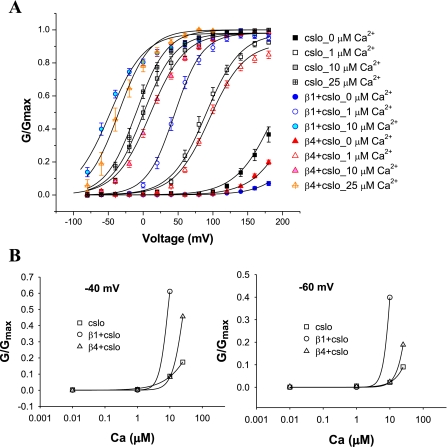Fig. 3.
β1 and β4 produce differential effects on conductance-voltage (G-V) relationships that are dependent on Ca2+ concentration. A: G-V relationships of inside-out macropatches from oocytes injected with Slo alone, Slo with β1, and, separately, Slo with β4, in different concentrations of “intracellular” Ca2+. Both β-subunits cause a shift in G-V function in a depolarizing direction in nominally Ca2+-free solutions. In contrast to β1, which causes a shift in a hyperpolarizing direction at all concentrations of Ca2+ (1 μM and greater), β4 causes a shift in a depolarizing direction in G-V relationships except when the concentration of intracellular Ca2+ exceeds 25 μM (and above). cSlo, n = 11; cSlo + β1, n = 12; cSlo + β4, n = 15. B: β4 increases Ca2+ sensitivity of BK channels at voltages that span a hair cell's operating voltage range (−50 mV ± 5 mV). The effects of increasing Ca2+ concentration on G/Gmax at both −60 mV and −40 mV reveal β4 to sensitize Slo to physiological concentrations of Ca2+ (5–50 μM). There is a dramatic rise in current in the presence of the β4-subunit. In contrast, the β1-subunit confers increased channel opening at <10 μM Ca2+, at these voltages (cSlo, n = 11; cSlo + β1, n = 12; cSlo + β4, n = 15).

